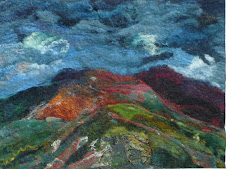Hurray! My online shop is open. T'is a small thing but it will grow! I have always wanted to have a shop but the idea of standing behind a counter all day is another thing so a virtual shop is ideal for me. Anyway it is open and if you want to felt with naturally dyed fibres this is the place for you. and of course if you want to buy one of my pictures or books.
The only problem with a shop and a blog is that I swear my eyes are going square! However I love my blog and can't think why it has taken me so long to get here and do one. Mind you I notice that nothing very much is getting done in house and garden.
I have uploaded the yellow fibres dyed with buckthorn bark. It is a lovely soft golden yellow but goes orangy/pinkish with ammonia. I tried the full colour modification a la Fred Gerber. The original mordant was Alum @ 8%A 7%CT. Then I split it into 8 pots with about 50ml of dye and a drift of the merino tops. I added a grain or so ( it is not terribly precise I am ashamed to say) So the first sample is alum only. 2.alum + ammonia. 3.Tin. ( ie stannous Chloride. 4 Tin+ ammonia.5 Copper ( copper sulphate) 6. Copper + ammonia 7.Iron ( ferrous Sulphate) 8. Iron + ammonia. The copper and ammonia is a nice colour a sort of purplish brownish pink. Very much the colour the birch trees look at distance when they have lost their leaves. The fermenting one is still bubblin gently away at about 45 degrees C and a pH of 7. I dropped a tiny drift of merino fibres in and for the first two days these looked a deep brassy yellow now they appear to be taking on a russet hue.
I am really looking forward to seeing the fermented result and then I shall try it with alder buckthorn and I hope beechwood ash, the first I have ordered and the second I shall have to create using beech wood chips which now no less than three woddturners have promsied.
I discovered that a friend Debbie has a 1lb of blackoak bark. This too I have never tried and I really want to having heard what a fantastic lighfast yellow it makes and is very strong. So Debbie gave me 100g to try out along with some whitebark oak she bought in error to see whether that gives any result. These two are now in soak so I am hoping to dye with them over the next few days. Black oak bark has not been possible to get hold of till recently and not at all in the UK and I know that Bill Bailey, a member of natural dyes online harvested a lot, which he sold to Hillcreek Studios & Aurora silks. This particular batch came from Earthues.
Back to brief comment on woodash. Hi Leena I think that juniper is an alum accumulater and so works as alum mordant ( but I could be wrong).






































